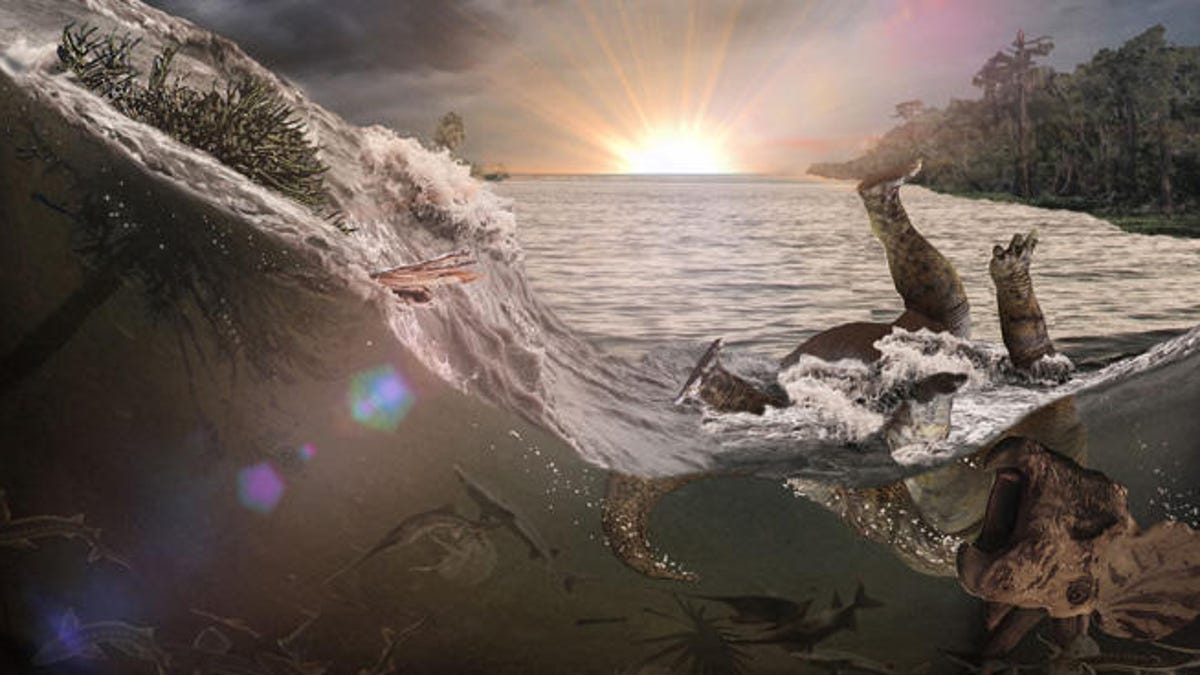Scientists uncover fossils from moments after Earth's apocalyptic asteroid collision
An unbelievable find provides new evidence of what happened on the day the dinosaurs went extinct.

Paleontologists working in the northern United States have uncovered one of the most remarkable collections of fossils ever discovered, dating back to the day a giant asteroid slammed into a shallow sea on the primordial Earth 66 million years ago.
In the immediate aftermath of that asteroid impact, unimaginable flooding swept across the planet. Earth shook with severe quakes the likes of which had never been felt before. Though the asteroid landed in what is now Mexico, it was so devastating that the effects were felt thousands of miles away, due to the Earth's tumultuous rumbling.
Hellfire and glassy, tiny beads -- tektites -- rained down upon the soil before dust and soot clouded the atmosphere. The sun was gone. As a result, approximately 75 percent of all living creatures, and most of the dinosaurs, are believed to have gone extinct.
The tektites rained down upon fish, railed against the trees and pounded the dinosaurs. Life perished quickly and the bodies of the dead settled in the soil, glassy beads still wrapped in their bones. Now those skeletons are being pried from the Earth -- and they're revealing, for the first time, exactly what happened after the asteroid hit.
In a paper due to be published in PNAS at 9 a.m. ET Monday, Robert A. DePalma and a team of paleontologists detail their mammoth haul of fossils found in the Hell Creek geological formation, which spans North Dakota, South Dakota, Wyoming and Montana. In conjunction, a fascinating account by Douglas Preston appeared on March 29 in The New Yorker detailing DePalma's discoveries and seven years at the site, which the paleontologist has christened "Tanis" after the ancient Egyptian city featured in Raiders of the Lost Ark.
To understand the importance of the discoveries at Tanis, one must understand the importance of the "Cretaceous–Paleogene (K–Pg) boundary," a layer of rock buried within the Earth that delineates the end of the Cretaceous period and the beginning of the Paleogene -- the era we live in today.
That boundary is believed to have been formed when the gigantic asteroid slammed into the Earth, depositing a dark layer of dust within the Earth. For years, scientists have probed the region looking for fossils but have not discovered bones resting close to the boundary. Without fossils close to the boundary, some scientists had suggested the dinosaurs may have been in decline long before the cataclysmic asteroid collision.
But in Hell Creek, DePalma has found fossils of fish, seeds, dinosaurs and, reportedly, even mammal burrows embedded underneath that dark layer, close to the boundary.
The hypothesis is that, in the hours following the asteroid impact, a huge surge of water rushed into the area, leveling everything in its path. The tektites that fell around the impact crater were swept thousands of kilometers north and ended up lodged in the gills of fish found at the site. The findings provide startling new evidence of how the Earth responded in the moments after the planet's brush with oblivion.
"It solves the question of whether dinosaurs went extinct at exactly that level or whether they declined before," Jan Smit, a paleontologist and co-author on the paper, told the New Yorker. "And this is the first time we see direct victims."
Ultimately, the tangled graveyard provides a snapshot of the day the Earth trembled -- and potentially the last day dinosaurs roamed the Earth.

